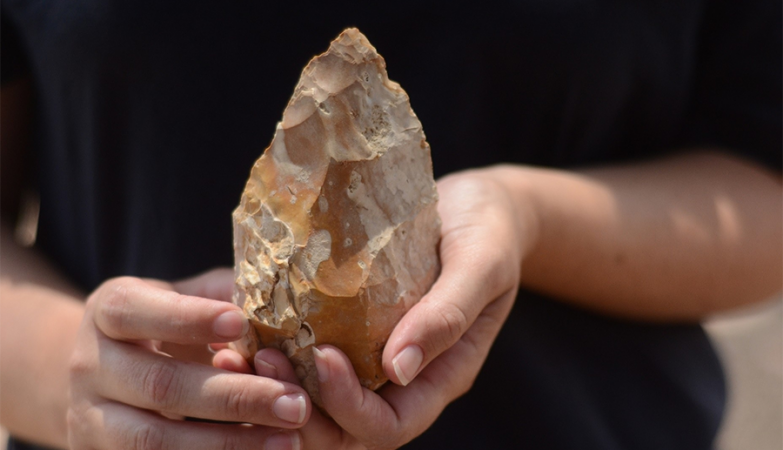IAA / Facebook

Arqueólogos israelenses descobriram um local pré-histórico raro próximo da cidade de Tel Aviv. Trata-se de um antigo “paraíso” para caçadores-coletores que viveram há 500 mil anos.
O local, próximo de uma estrada movimentada na cidade de Jaljulia, perto de Tel Aviv, em Israel, abrigava centenas de eixos de pedras e de outros artefatos pré-históricos. Os especialistas dizem que a área tinha um rio e vegetação e animais em abundância – ou seja, era o local perfeito para os humanos primitivos.
O responsável pela Arqueologia da Universidade de Tel Aviv, Ran Barkai, afirma que o espaço está “incrivelmente preservado”, revela a BBC. O local “era como um paraíso”, destaca Barkai, notando que os humanos primitivos se deslocavam até lá “repetidas vezes”.
“A água trazia pedaços de pedras das montanhas que eram usados para fazer ferramentas”, realça o arqueólogo, frisando que “também atraía animais” que eram “caçados e abatidos”.
“O local tinha tudo o que as pessoas pré-históricas precisavam“, afirma.
O sítio arqueológico foi encontrado entre Jaljulia e a autoestrada 6, cerca de cinco metros da superfície. As descobertas indicam que foi usado pelos antepassados dos humanos modernos, os chamados Homo erectus – a primeira espécie humana a caminhar completamente em pé.
Essa espécie era formada por homens um pouco maiores e mais fortes do que os humanos modernos, mas seus cérebros não eram evoluídos.
A Autoridade de Antiguidades de Israel, IAA, que realizou a escavação que levou à descoberta, em conjunto com a Universidade de Tel Aviv, refere que as descobertas lançam uma nova luz sobre o período pré-histórico.
“A descoberta é incrível pelo estado de preservação das peças e pelas suas implicações na nossa compreensão dessa cultura material”, destaca à BBC o diretor de escavações da IAA, Maayan Shemer.
“Não há dúvida de que analisar estes achados em detalhes contribuirá significativamente para a compreensão do estilo de vida e do comportamento dos humanos durante o período”, acrescenta Shemer.
An Important and Rare Prehistoric Site about Half a Million Years Old Uncovered in Jaljulia in the Sharon Region
Watch: An astonishing discovery in Jaljulia, Israel: a rare and important prehistoric site, roughly half of a million years old, extending over about 10 dunams, was uncovered during the last few months in a joint archaeological excavation conducted by the Israel Antiquities Authority in cooperation with the Archaeological Department in Tel Aviv University. The archaeological excavation was funded by the Israel Land Authority, towards the expansion of Jaljulia.The excavation revealed a rich lithic industry, including hundreds of flint hand axes, typical tools of the ancient Acheulian culture. According to Maayan Shemer, the excavation director on behalf of the Israel Antiquities Authority, and Prof. Ran Barkai, head of the Archaeology Department at Tel Aviv University: “The extraordinary quantity of flint tools uncovered in the excavation provides significant information about the lifeways of prehistoric humans during the Lower Paleolithic period. It seems that half a million years ago, the conditions here in Jaljulia were such, that this became a favored locality, subject to repeated human activity. We associate the industry found on site to the Homo Erectus – a direct ancestor of the Homo Sapiens Sapiens, the human species living today. A geological reconstruction of the prehistoric environment, shows that the human activity took place in a dynamic environment, on the banks of an ancient stream ( possibly Nahal Qaneh, which now flows approximately 500 m' south of the site). This environment is considered to have been rich with vegetation and herding animals, a ‘green spot’ in the landscape. In this place, three basic needs of the ancient hunter gatherers were met: clear water, a variety of food sources (plants and animals) and flint nodules, of which tools were made. The fact that the site was occupied repeatedly indicates that prehistoric humans possessed a geographic memory of the place, and could have returned here as a part of a seasonal cycle.”Handaxes, found at the site in relatively large quantities, are very impressive tools, their shape somewhat reminding a teardrop. The production of these tools require careful and meticulous work, and a deep familiarity of the raw material in use. In Jaljulia handaxes were made of a variety of flint types, and we also observe a differentiation in the production quality. Almost as if some of the handaxes were made by a master craftsmen and others- by someone less qualified. Hand axes were used as dominant tools by prehistoric humans for more than a million years. Yet, its particular use is still debated. Some scholars suggest that these were the tools used to dismember large animals such as elephants. Others say that handaxes were the “Swiss Army knife” of the Stone Age and had additional uses such as hunting, hide working and the working plant and vegetal material. Large quantities of additional flint artifacts attest to technological innovation, development and creativity Maayan Shemer, the excavation director on behalf of the Israel Antiquities Authority, said: “Coming to work in Jaljulia, nobody expected to find evidence of such an ancient site, let alone one so extensive and with such impressive finds. There are only two sites whose estimated age is close to Jaljulia in the Sharon, or central Israel: one in Kibbutz Eyal, approximately 5 km to the north, and the other, dated to a slightly later cultural phase, at Qesem Cave located approximately 5 km to the south. The findings are amazing, both in their preservation state and in their implications about our understanding of this ancient material culture. We see here a wide technological variety, and there is no doubt that researching these finds in-depth will contribute greatly to the understanding of the lifestyle and human behavior during the period in which Homo Erectus inhabited our area.Prof. Ran Barkai, head of the Archaeology Department of Tel Aviv University: “It’s hard to believe that between Jaljulia and highway 6, five meters below the surface, an ancient landscape some half of a million years old has been so amazingly preserved. This extraordinary site will enable us to trace the behavior of our direct prehistoric ancestors, and reconstruct their lifestyle and behavior on the very long journey of human existence. The past of all of us, of all human beings, is buried in the earth, and we have a one-time opportunity to travel back half a million years and better get to know the ancient humans who lived here before us, between Jaljulia and road 6.”**Please Like and Share!**
Posted by רשות העתיקות – לגעת בעבר on Sunday, January 7, 2018













